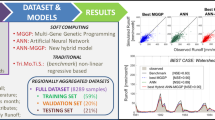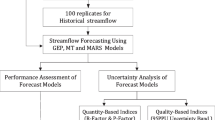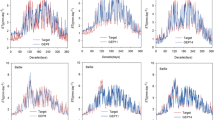Abstract
Forecasting Urban Water Consumption (UWC) has a significant impress in efficient urban water management in rapidly growing cities in arid regions. Enhancing forecasting accuracy of UWC using novel models is a crucial requirement in order to the management of smart cities. In this study, Bayesian Networks (BN) is developed as a probabilistic model and compared to Gene Expression Programming (GEP) model as an evolutionary algorithm for forecasting UWC. The amount of current water consumption predicts future water consumption. The scenario with sunshine hours was added to the parameter set as the best scenario in both BN and GEP models based on comparison of Root Mean Square Error (0.11, 0.16), Mean Absolute Relative Error (0.02, 0.05), Max Root Error (0.26, 0.26), and Coefficient of determination (0.8, 0.7), respectively. The outcomes indicate that the BN model provided a more desirable efficiency compared to the GEP model. Furthermore, it can be concluded that the sunshine hour has a considerable influence on UWC, and the ability of the BN model is greatly enhanced by adding this predictor to forecast UWC in a city in an arid region with rapid population growth.
Article highlights
-
BN and GEP models were developed for forecasting Urban Water Consumption.
-
The BN model provided a more accurate and desirable performance than the GEP model.
-
The forecasting of UWC was enhanced using new predictors comparing to former models.





Similar content being viewed by others
Data availability
Not applicable.
Code availability
Not applicable.
References
Abebe Y, Kabir G, Tesfamariam S (2018) Assessing urban areas vulnerability to pluvial flooding using GIS applications and Bayesian Belief Network model. Journal of Cleaner Production 174:1629–1641
Adamowski J, Fung Chan H, Prasher SO, Ozga-Zielinski B, Sliusarieva A (2012) Comparison of multiple linear and nonlinear regression, autoregressive integrated moving average, artificial neural network, and wavelet artificial neural network methods for urban water demand forecasting in Montreal. Canada. Water Resources Research 48:1
Al-Zahrani MA, Abo-Monasar A (2015) Urban Residential Water Demand Prediction Based on Artificial Neural Networks and Time Series Models. Water Resources Management 29(10):3651–3662
Anbari MJ, Tabesh M, Roozbahani A (2017) Risk assessment model to prioritize sewer pipes inspection in wastewater collection networks. Journal of environmental management 190:91–101
Azadeh A, Neshat N, Hamidipour H (2011) Hybrid fuzzy regression–artificial neural network for improvement of short-term water consumption estimation and forecasting in uncertain and complex environments: Case of a large metropolitan city. Journal of Water Resources Planning and Management 138(1):71–75
Azamathulla HM, Ghani AA, Leow CS, Chang CK, Zakaria NA (2011) Gene-Expression Programming for the Development of a Stage-Discharge Curve of the Pahang River. Water Resources Management 25(11):2901–2916
Azarnivand A, Banihabib ME (2017) Multi-Level Strategic Group Decision Making for Understanding and Analysis of Sustainable Watershed Planning in Response to Environmental Perplexities. A 26(3):629–648
Banihabib, M., 2019, Extended linear and nonlinear auto-regressive models for forecasting the urban water consumption of a fast-growing city in an arid region.: Sustainable Cities and Society, p. 48.
Banihabib ME, Ahmadian A, Jamali FS (2017) Hybrid DARIMA-NARX model for forecasting long-term daily inflow to Dez reservoir using the North Atlantic Oscillation (NAO) and rainfall data. GeoResJ 13:9–16
Banihabib, M. E., Bandari, R., and Peralta, R. C., 2018, Auto-Regressive Neural-Network Models for Long Lead-Time Forecasting of Daily Flow: Water Resources Management, p. 1–14.
Banihabib ME, Hashemi F, Shabestari MH (2017b) A framework for sustainable strategic planning of water demand and supply in arid regions. Sustain Dev 25(3):254–266
Banihabib ME, Shabestari MH (2017) Fuzzy Hybrid MCDM Model for Ranking the Agricultural Water Demand Management Strategies in Arid Areas. Water Resour Manage 31(1):495–513
Billings RB, Jones CV (2011) Forecasting urban water demand. American Water Works Association
Campbell HE, Johnson RM, Larson EH (2004) Prices, Devices, People, or Rules: The Relative Effectiveness of Policy Instruments in Water Conservation 1. Review of Policy Research 21(5):637–662
Ferreira C (2006) Gene expression programming: mathematical modeling by an artificial intelligence. Springer
Froelich, W., Forecasting daily urban water demand using dynamic Gaussian Bayesian network. In Proceedings International conference: beyond databases, architectures and structures 2015. Springer, p. 333–342.
Ghiassi M, Zimbra DK, Saidane H (2008) Urban water demand forecasting with a dynamic artificial neural network model. J Water Resour Plan Manag 134(2):138–146
Gu T, Pung HK, Zhang DQ (2005) A Service-Oriented Middleware for Building Context-Aware Services. Journal of Network and Computer Applications 28(1):1–18
Karimi S, Shiri J, Kisi O, Makarynskyy O (2012) Forecasting Water Level Fluctuations of Urmieh Lake Using Gene Expression Programming and Adaptive Neuro-Fuzzy Inference System. the International Journal of Ocean and Climate Systems 3(2):109–125
Khakzad N, Khan F, Amyotte P (2011) Safety analysis in process facilities: Comparison of fault tree Bayesian network approaches. Reliability Engineering and System Safety 96(8):925–932
Kisi O, Shiri J (2011) Precipitation Forecasting Using Wavelet-Genetic Programming and Wavelet-Neuro-Fuzzy Conjunction Models. Water Resources Management 25(13):3135–3152
Magiera E, Froelich W (2015) Application of Bayesian networks to the forecasting of daily water demand. Springer, Intelligent Decision Technologies, pp 385–393
Mikovits C, Rauch W, Kleidorfer M (2018) Importance of scenario analysis in urban development for urban water infrastructure planning and management: Computers. Environment and Urban Systems 68:9–16
Mittal A (2007) Bayesian Network Technologies: Applications and Graphical Models. Applications and Graphical Models, IGI Global
Pearl J (1988) Probabilistic reasoning in intelligent systems: Networks of plausible reasoning. Morgan Kaufmann Publishers, Los Altos
Sanikhani H, Kisi O, Kiafar H, Ghavidel SZZ (2015) Comparison of different data-driven approaches for modeling lake level fluctuations: the case of Manyas and Tuz Lakes (Turkey). Water resources management 29(5):1557–1574
Shiri J, Kisi O, Yoon H, Lee K-K, Nazemi AH (2013) Predicting groundwater level fluctuations with meteorological effect implications—A comparative study among soft computing techniques. Computers & Geosciences 56:32–44
Teh, Y., 2008, Bayesian agglomerative clustering with coalescents.: In Advances in Neural Information Processing Systems p. 1473–1480.
Tien EA (2016) Algorithms for Bayesian network modeling and reliability assessment of infrastructure systems. Reliability Engineering & System Safety, p. 156.
Wu ZY, Yan X (2010) Applying genetic programming approaches to short-term water demand forecast for district water system. Water Distribution Systems Analysis 2010:1498–1506
Yousefi P, Shabani S, Mohammadi H, Naser G (2017) Gene Expression Programing in Long Term Water Demand Forecasts Using Wavelet Decomposition. Procedia Engineering 186:544–550
Funding
Not applicable.
Author information
Authors and Affiliations
Corresponding author
Ethics declarations
Ethical Responsibilities of Authors
The authors undertake that this article has not been published in any other journal and that no plagiarism has occurred.
Consent to participate
The authors agree to participate in the journal.
Consent for publication
The authors agree to publish in the journal.
Conflicts of interest
The authors declare no conflict of interest.
Additional information
Communicated by: H. Babaie
Publisher's note
Springer Nature remains neutral with regard to jurisdictional claims in published maps and institutional affiliations.
Rights and permissions
About this article
Cite this article
Mousavi-Mirkalaei, P., Roozbahani, A., Banihabib, M.E. et al. Forecasting urban water consumption using bayesian networks and gene expression programming. Earth Sci Inform 15, 623–633 (2022). https://doi.org/10.1007/s12145-021-00733-z
Received:
Accepted:
Published:
Issue Date:
DOI: https://doi.org/10.1007/s12145-021-00733-z




